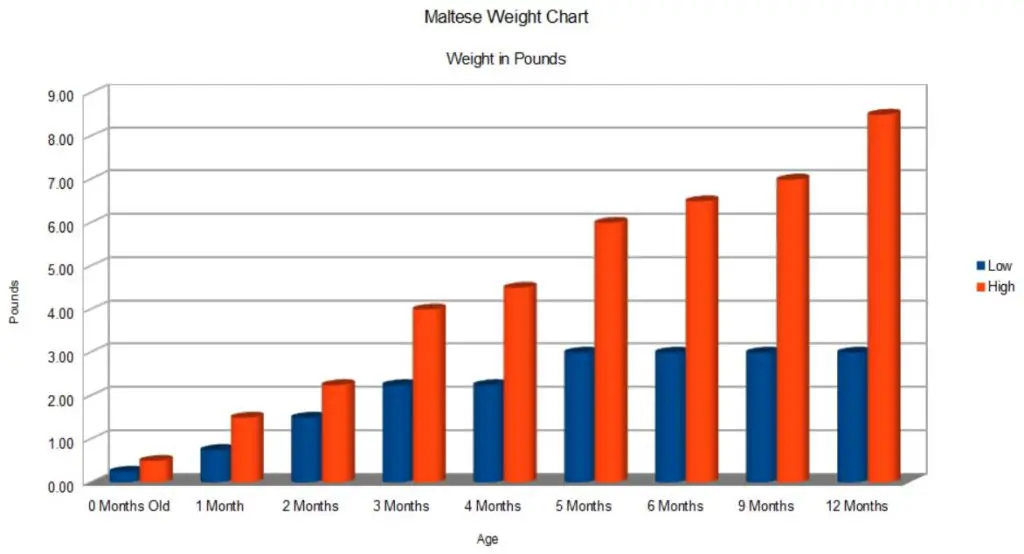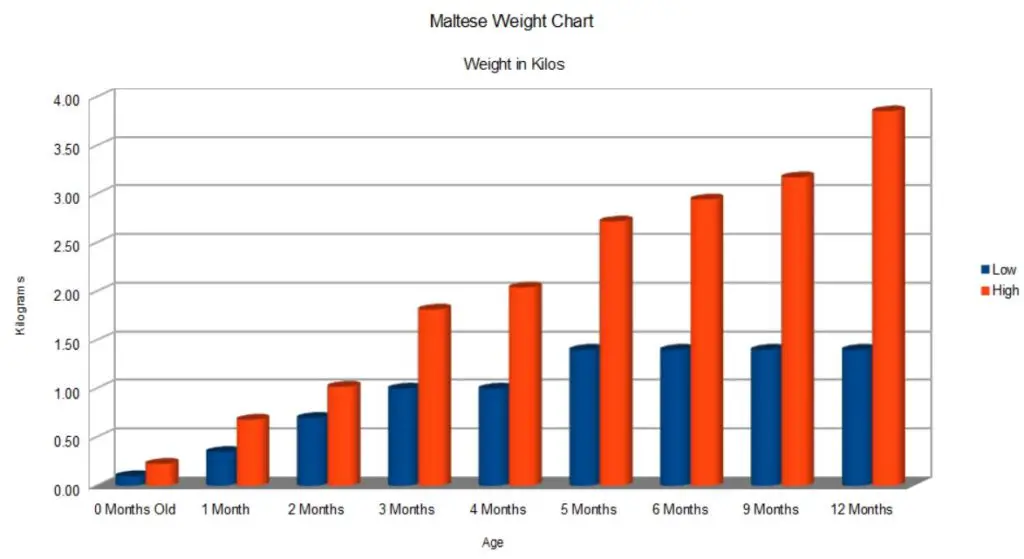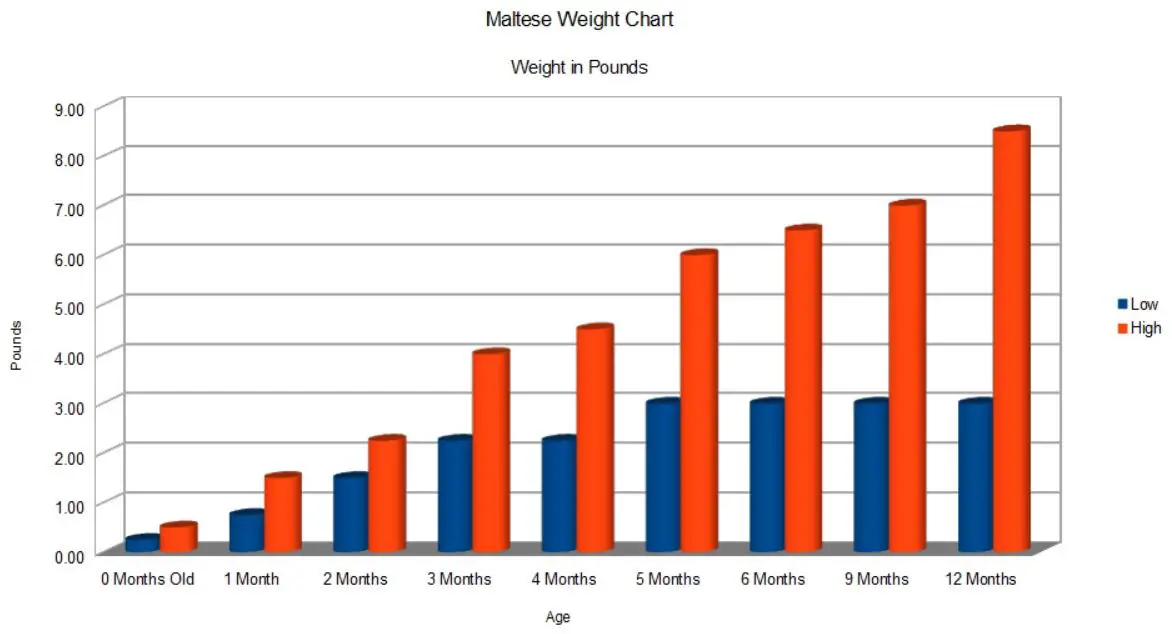Detailed Chart on Maltese Growth From Birth till Adulthood
Many people look at how small their little Maltese puppy is at three months and wonder just how big it might grow. They wonder what size their Maltese might be ? There are a few factors which can affect the growth rate of a Maltese puppy and affect Maltese size. Generally though they will fit within a fairly standard growth range as they age. The biggest difference factor for growth will be the type of Maltese puppy you have chosen to be part of your family.
Most puppies will continue to grow till about nine months old but it can continue through to 12 months old. The growth curve will tail off quickly after about 6 months. Most Maltese puppies will grow to a maturity weight of around 7 lbs. Keep in mind this is the average weight and your Maltese may end up in the weight range of 6.6 lbs to 8.8 lbs and will depend on a few factors including diet. At maturity they will be approx 8 to 10 inches tall although males in the Maltese breed tend to grow slightly larger than the females.
Maltese Puppies Growth Rate (in pounds)

Maltese Puppies Growth Rate (in Kilograms)

Maltese puppies will grow at different rates during their puppy months. Some will grow quickly and reach their adult weight and height by 6 months while others will grow into it slowly and take all 9 months to completely grow out. A few factors can affect this growth rate. These factors include:
- Genes. The factor which has the most impact is the puppies genes from its parents. Genes will control the rate of growth providing all the other important factors for a puppies development are adequate. This is nothing you can do about your Maltese puppies genes but you can ensure that your puppies is healthy and loved.
- Diet. Diet can affect weight especially if you are under feeding or over feeding your dog. Obviously a dog which eats too much will tend to put on weight more rapidly although this may not be healthy. As a breed Maltese dogs are known for being food focused so over feeding is not normally an issue. Under feeding is a much More common issue. Maltese tend to eat only what they want unless it is something they absolutely love (chicken, liver, treats, etc). Underfeeding your dog can lead to stunted growth and an unhealthy situation. Ensure that your dog is given adequate food at least twice a day while a puppy and reducing it to once a day once your Maltese matures into adulthood.
- Good Quality Food. The type of food you feed your Maltese can affect its ability to grow. Some low quality food will not offer enough nutrients as it will be full of fillers which contain little or no nutrients required by a growing puppy. The major problem with these fillers is that your puppy will feel full and stop eating and not get all of the required nutrients causing a stunting of the growth.
- Exercise. Adequate activity is required to stimulate growth and allow bone density to be developed. Stronger bones and a leaner body will add weight to your puppy while keeping them healthy. Exercise will also tend to work off any extra calories if your puppy over eats on occasion.
- Health and Diseases. If your puppy has any infections, viruses, or congenital diseases there is a likelihood they will affect the growth rate. Viruses and infections can make your puppy feel like not eating or could inhibit the absorption of the required nutrients for a growing puppy.

A quick guide to the growth you should expect is:
- Newborn puppies should be adding weight each and every day up till 3 months.
- A puppy from 3 months to 6 months should add weight more gradually as they continue to grow. If is very possible for two puppies to have very different weights at 3 months and by the time they reach 6 months the difference will be dramatically reduced.
- A puppy from 6 months of age will continue to grow at a slower rate till they reach close to their adult weight by 9 months.
- 9 months and onward weight gains will largely be due to diet and exercise.
If your Maltese puppy is generally towards the extremes of the chart they will likely stay on the extremes. So if they are at the minimum weight for that puppy age they will likely end up at the lower weight of an adult Maltese. Likewise if your Maltese is on the big size and pushing the maximum weight sizes when they are a puppy then you should expect that they will be a big Maltese and push the upper limits of weight and height as a full grown Maltese.
A quick table of expected weights for a Maltese puppy:
| Age Of Maltese | Weight Range |
| 1 Months | 0.25 lbs to 0. 5 lbs |
| 2 Months | 1.5 lbs to 2.25 lbs |
| 3 Months | 2.25 lbs to 4.0 lbs |
| 4 Months | 2.3 lbs to 4.5 lbs |
| 5 Months | 2.5 lbs to 6.0 lbs |
| 6 Months | 3.0 lbs to 6.5 lbs |
| 9 months | 3.5 lbs to 7.5 lbs |
| 12 Months (1 year) | 6.0 lbs to 8.8 lbs |

There are common questions which prop up with a Maltese puppy growth rate into a full grown adult. The section below tries to answer all of those questions you may have or might not have thought of but are interesting:
Question: Does the size of the parents of my Maltese puppy give me a good indication of its likely full grown size?
Answer: Genes are a very important factor in the full grown size of a Maltese. But there are exceptions. If you notice the parents were small in size but your puppy is on the higher extremes of the weight and height charts then it is likely your puppy will grown larger than its parents. But for the most part looking at the size of the parents will give a close indication of what you can expect as the expected size of your new Maltese puppy. The reason exceptions occur is that genes can go back several generations through the sire or dam’s history. Not many people have the family history of their puppies going back more than one generation.
Question: The dog breeder I bought my puppy from promised that it would only grow to a certain size. Its approaching that size and is still less than 6 months old. Was the breeder wrong ?
Answer: Any reputable Maltese breeder will make promises around a Maltese full grown size. They can give an indication that it might be within a certain range as an adult but they will also let you know that exceptions can happen. Just understand that your Maltese puppy could grow within the expected ranges of 6.6 – 8.8 lbs and 8 to 10 inches when they are fully grown with a higher likely that it will be smaller with a female than a male Maltese. As long as your Maltese is a pure bred then it will likely be within a very fine range of 6.5 lbs to 8 lbs. If the Maltese is not a pure bred then its size could vary considerably depending on the other breeds which are in the mixture of its genes.
Question: What is the difference between a toy Maltese, miniature Maltese and a teacup Maltese in regards to weight, height and size?
Answer: Firstly it should be known that there is no breeds within the Maltese breed called teacup Maltese, toy Maltese or miniature Maltese. The Maltese breed are known as a toy breed and hence toy Maltese is a fairly common term to describe a Maltese. A toy breed is dogs which are small in size of which Maltese are one of the smallest already at only an average weight of 7 lbs. Teacup Maltese and Miniature Maltese can be used to describe the same types of dogs within the Maltese breed. A teacup Maltese is a Maltese which has been bred to only grow to the lower end of the average size of the Maltese breed. This is done by breeders who are trying to sell to a niche part of the market who see small dogs as cute as they can be carried in a handbag. One thing very important to keep in mind with Teacup Maltese and Miniature Maltese is that they are more prone to serious health issues. This is because they are bred to be unnaturally miniature in size and the runts of the litter are generally those which are sort for breeding these types of dogs. Generally the runt is small then the rest of the puppies because of health issues which have stunted their growth.
Question: My Maltese puppy is growing quickly and appears to be in some discomfort during the night. Can this be due to growing pains or should I get it checked out by a Vet?
Answer: If you notice our puppy in pain or discomfort and it does not get better within a couple of days, or the condition gets worse or its affecting how much they are eating then you should take them to a veterinarian to get a full checkup. It may be growing pains or it may be more serious so professional advice is the way to go if you are concerned.
Question: How does the Maltese breed compare in size to other Toy Breeds ?
Answer: The Maltese breed is one of the smallest toy breeds. Toy breeds are generally up to 16 inches tall. The smallest toy breeds are around 6 inches tall. The Maltese comes in around 8 inches to 10 inches but can be as low as 6 inches height. Even the smallest breeds such as the Chihuahua will still range from 6 inches to 10 inches which puts the Maltese squarely in the same category of the smallest of the toy breeds.

Summary on weight and height on the growth rate a Maltese
Maltese are generally a small dog breed and are regarded as a toy breed. They will range in weight from 6 lbs to almost 9 lbs for a pure bred Maltese.
What size is your Maltese ? Let us know in the comments if you have a smaller Maltese or a larger Maltese.

I bought a Maltese dog it is 4 months old and I have already spent a lot of money on products for tear stains,,,,,nothing has worked very frustrating
Joan??
Joan,
Tear stains can be tricky to get rid of. Have you tried everthing in the article? Whats the best thing which has so far worked for you?
Are you planning on having a show dog or is your Maltese just a pet?
Our Maltese puppy had tear stains till our vet told us to start giving her filtered water. The tear stains stopped immediately.
Thats a great tip. What methods had you tried before that?